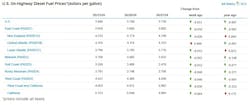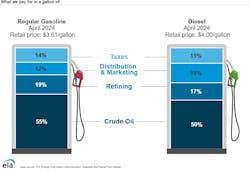Fuel demand consistent, national diesel and gas prices down
After Memorial Day weekend, both diesel and gasoline prices dropped—if only by incremental amounts—according to the U.S. Energy Information Administration. The U.S. on-highway diesel fuel price average fell 3 cents to $3.758 per gallon, while the gasoline average dropped less than a cent to $3.577 per gallon.
Diesel prices also dropped in most regions across the country, save for the Central Atlantic sub-region, where costs rose less than a cent to $4.123. Otherwise, prices dipped the least along the East Coast and Gulf Coast. On the East Coast, diesel prices fell 1 cent to $3.885 per gallon, while the Gulf Coast dropped the same amount to $3.478. The West Coast without California dropped 3 cents to $3.982 per gallon.
On the other hand, diesel costs dropped the most in California, where prices fell 6 cents to $4.985 per gallon. Trailing just behind that, the Midwest experienced a diesel price cut of 5 cents to $3.633, and the Rocky Mountain region lost 4 cents in diesel costs to reach $3.706. With these changes in mind, the Gulf Coast is still the cheapest place to buy diesel fuel at $3.478 per gallon, while California on its own is the most expensive at $4.985.
Additionally, the EIA recently released its breakdown of diesel component pricing about the overall costs for April. With a cited retail price of $4 per gallon, the Administration found that the cost allotted to refining dropped 2% from March while that of crude oil increased 3%. Overall, this equates to 60 cents (15%) toward taxes, 76 cents (19%) toward distribution and marketing, 68 cents (17%) toward refining, and 2 dollars (50%) toward crude oil costs.
Meanwhile, the AAA motor club is still logging diesel prices higher than those at the EIA—about 11 cents more expensive at $3.863 per gallon. This price is 4 cents cheaper than last week’s average of $3.906, and 10 cents cheaper than last year’s average of $3.964 per gallon.
Gasoline prices stagnant at $3.577 per gal.
While gas prices were more erratic the week of May 27, the overall nationwide average for gas decreased less than a cent from last week and this time last year. Otherwise, price changes across the country tended to vacillate from less than a cent to 7 cents.
See also: Diesel prices fall to $3.789/gal. leading to Memorial Day
Specifically, prices increased 1 cent on the East Coast to $3.485 per gallon. Prices also increased by 1 cent in the Central Atlantic and Lower Atlantic sub-regions, which the EIA logged at $3.640 and $3.376 per gallon, respectively. The Midwest also saw a price increase of 2 cents to $3.459 per gallon.
For regions where gas prices decreased, gas costs dropped less than a cent in the New England sub-region to $3.536 and less than a cent in the Gulf Coast to $3.112 per gallon. In stark contrast, the Rocky Mountain region’s gas prices dropped 7 cents to $3.354 per gallon, and the West Coast’s gas costs dropped 5 cents to $4.571 overall. At this rate, the Gulf Coast is the cheapest place for on-highway gasoline at $3.112 per gallon, while California is the most expensive at $4.892.
In comparison, the motor club currently logs its national gas price average at $3.586 per gallon, 1 cent lower than last week. According to the group, last year’s gas average at this time was $3.578.
“Since the pandemic, the summer driving season has not seen a surge in demand, which can push pump prices higher,” said Andrew Gross, AAA spokesperson, in a press release. “So, it will be interesting to see if this year bucks that trend. This week’s move by the Biden Administration to sell off the million-barrel Northeast Gasoline Supply Reserve might help stave off any regional pump price surges, but likely won’t move the national average that much.”
About the Author
Alex Keenan
Alex Keenan has been associate editor for Endeavor's Commercial Vehicle Group, which includes FleetOwner magazine, since 2022. She has written on a variety of topics for the past several years and recently joined the transportation industry, reviewing content covering technician challenges and breaking industry news. She holds a bachelor's degree in English from Colorado State University in Fort Collins, Colorado.



